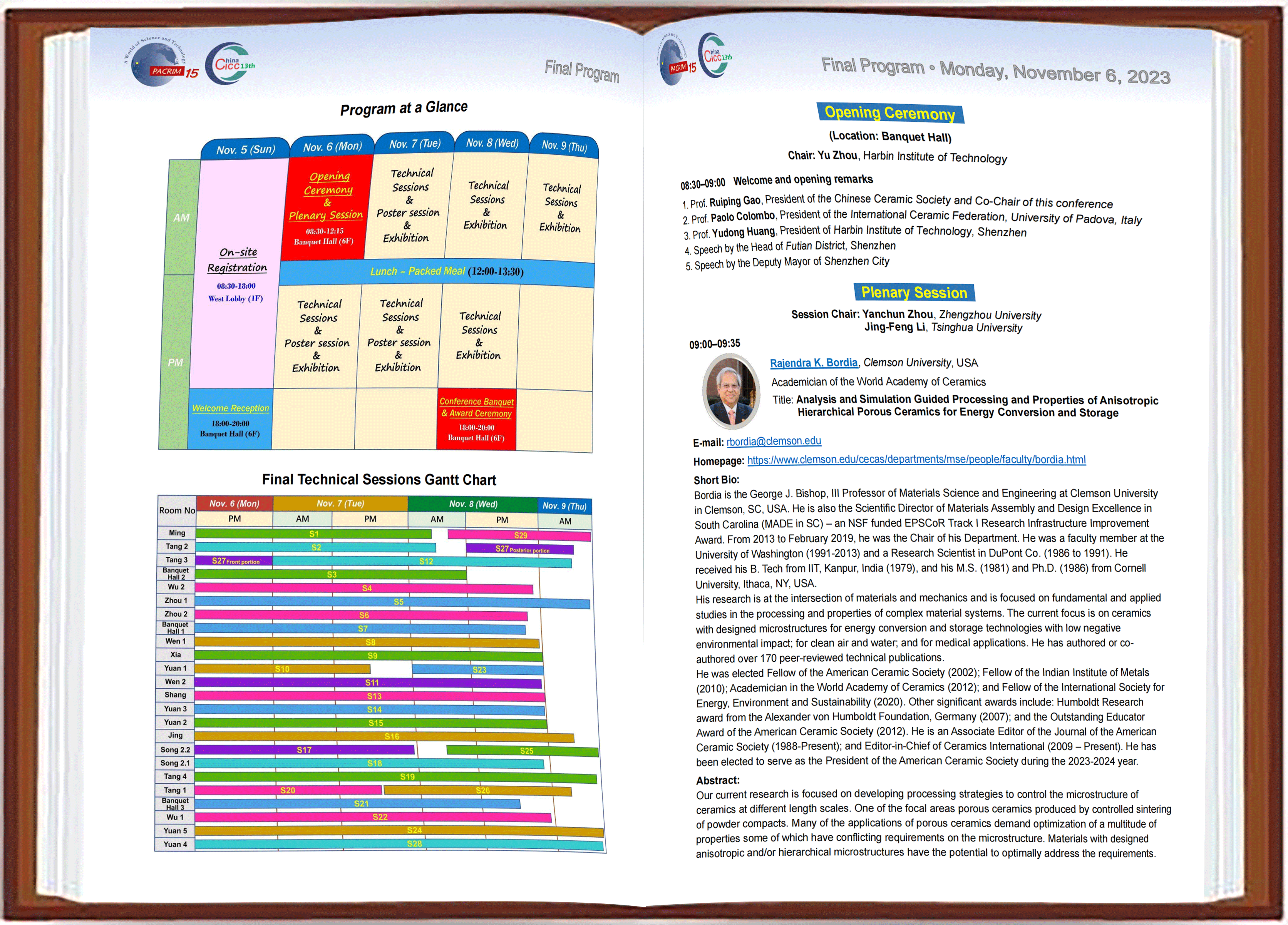Home >Symposium

- Registration is NOW OPEN! The early-bird deadline is Sep. 30, 2023. Please don't miss out on the early registration rate! Aug. 21, 2023
- Abstract Submission has been extended to Aug. 15, 2023! Take advantage of the LAST OPPORTUNITY to submit and present your research at the PACRIM15 & CICC-13!
- 3rd announcement-call for abstracts (full-text version)
- 3rd announcement-call for abstracts (short version)
- 2nd announcement-revised version
Venue & address
Contact us
Symposium 26
Bioceramics and Ceramics Coatings for Biomedical Applications
Biocermics (including bioglass) are a variety of advanced biomaterials, which have been used in bone tissue repair and soft tissue repair, due to their excellent biocompatibility, tissue-repairing activity. Bioceramic-based coating is also used to fabricate high quality of artificial joint and dental implants for enhancing their applications. In recent years, new technologies including 3D printing and nanofabrication have been developed for designing and fabricating advanced bioceramics and bioglass biomaterials and implants for improving the biomedical applications. In addition to the conventional bone and dental repair applications, the new biomedical applications such as tumor therapy, gene/drug delivery and bioimaging based on novel bioceramics biomaterials are also reported. The main advances in the fabrication and applications of bioceramics and bioglass would be shared in this section.
Proposed sessions
| ª | Advanced bioceramics for bone/dental repair and regeneration |
| ª | Advanced bioceramics coating for bone/dental reconstruction |
| ª | Advanced bioceramics for soft tissue repair and regeneration |
| ª | Advanced bioceramics for disease theranostics |
Organizers
| - | Xiaofeng Chen (Points of Contact),South China University of Technology, China, chenxf@scut.edu.cn |
| - | Bo Lei (Points of Contact), Xi'an Jiaotong University, China, rayboo@xjtu.edu.cn |
| - | Chengtie Wu (Points of Contact), Shanghai Institute of Ceramics, Chinese Academy of Sciences, China, chengtiewu@mail.sic.ac.cn |
| - | Aldo R. Boccaccini, University of Erlangen-Nuremberg, Germany |
| - | Zhiping Xu, The University of Queensland, Australia |
| - | Toshiyuki Ikoma, Tokyo Institute of Technology, Japan |
| - | Rizhi Wang, University of British Columbia, Canada |
| - | Mei Wei, University of Connecticut, USA |
| - | Chong Wei, Northwestern Polytechnical University, China |
| - | Congqin Ning, Shanghai Normal University, China |
Keynote Speakers
 |
|
|||||||
|
apore in 2001 after his Bachelor and MSc degrees from University of Science and Technology of China. He then did his postdoctoral research at the University of North Texas from 2001 to 2003, followed by a research fellow position at the University of Queensland (UQ) from 2003 to 2007. He further progressed at UQ as a Senior Research Fellow, Associate Professor and Professor. Currently, he is a Senior Group Leader at the Australian Institute for Bioengineering and Nanotechnology, UQ, and a Principal Investigator in Shenzhen Bay Laboratory. His research focuses on rational design and controlled preparation of layered double hydroxide nanomaterials, and their applications in biomedicine and agricultural biotechnology. He has published over 350 papers, with over 21,000 citations and H-index of 78.
|
||||||||

|
|
|||||||
|
Research Council (NHMRC) Leadership Fellow in the School of Chemical Engineering at University of Adelaide, the Node leader and Program Leader of ARC Centre of Excellence, and an Honorary Professor at the Australian Institute for Bioengineering and Nanotechnology, The University of Queensland. She leads a research group focusing on bioinspired engineering, biomimetic nanomaterials and microfluidics for drug delivery and controlled release. She has been awarded three national prestigious fellowship (Australian Postdoctoral Fellowship 2011-2014 and Australian Research Council (ARC) Future Fellowship 2015-2020, and NHMRC Leadership Fellowship 2022-2026). Her research in bio-inspired nanotechnology and microfluidics has attracted more than $12 M research funding as the chief investigator plus $35M ARC Centre of Excellence, $7.35M Cooperative Research Centres Projects (CRC-P) Grant, $10M MRFF grant, and many university and industry grants.
|
||||||||

|
|
|||||||
|
to replace or repair damaged hard tissues. However, some inherent drawbacks of ceramics such as brittleness, have inhibited their wider applications in dental restorations or load-bearing orthopaedic implants. Current strategies to enhance the mechanical properties of ceramics while maintaining their biological functions are not without limitations; some ceramic properties are mutually exclusive, reinforcing in one property may result in compromised performance in other aspects. Teeth and bones are ceramic composites with exquisitely hierarchical structures at multi-length scales and optimal mechanical/biological properties. But it is difficult to emulate their complex microstructure and properties from a top-down approach. Inspired by nature, we use a range of fabrication techniques to produce nacre-like ceramic composites with a simple 'brick and mortar' structure from ceramic powders with different shapes and compositions. In this talk, examples of some of the developed nacre-like ceramic composites will be given and their potential applications in dentistry and orthopaedics will be discussed.
|
||||||||

|
|
|||||||
|
Organs Degeneration, Shenzhen Institute of Advanced Technology, Chinese Academy of Science. He has published more than 150 peer-reviewed articles and awarded more than 30 patents, in which 13 patents have been commercialized. He found the alkaline condition is particularly important to enhance bone formation, and thus developed a few biomaterials to locally adjust the pH. The clinical trial indicates the satisfied effects. In the past ten years, he leaded a big research group to focus on the mechanism of osteoporosis and its related bone implants. The products may be in market in two years.
|
||||||||
Invited Speakers

|
|
||||

|
|
||||

|
|
||||

|
|
||||

|
|
||||

|
|
||||

